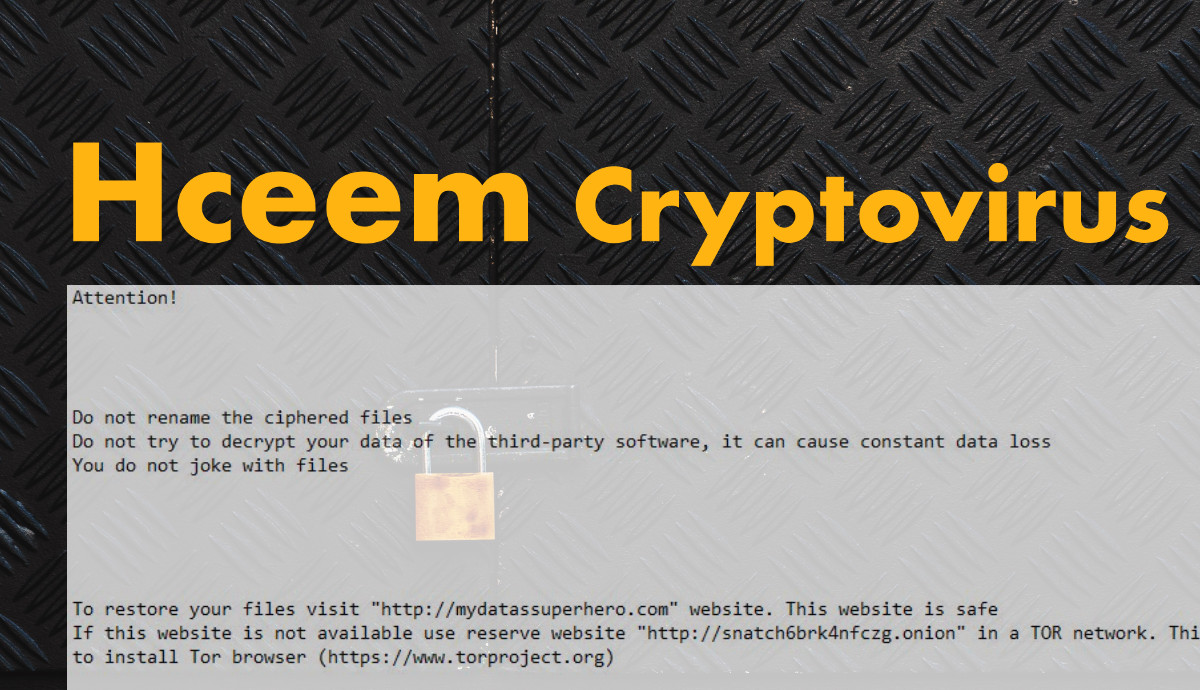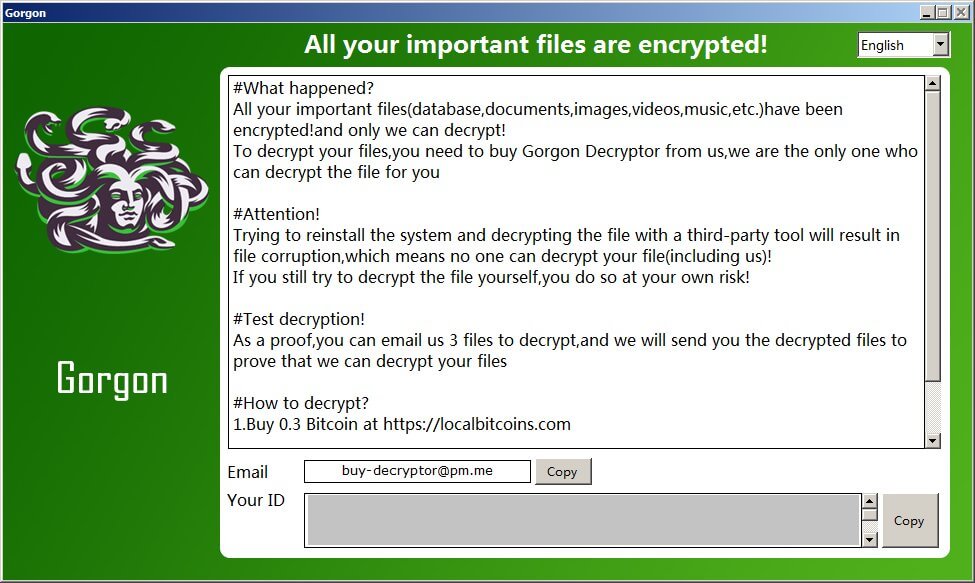What is Hceem ransomware? And how does it implement its attack?
Hceem ransomware is ransomware-type of threat that could do serious damage to an infected computer by encrypting valuable files. It is a new variant of Snatch ransomware and uses a “.hceem” extension in marking the files it encrypts. Based on the analysis done by security experts, this new Snatch variant only differs from its predecessor in the extension it uses and its ransom note. It still follows the same pattern in implementing its attack in a targeted computer.
The instant it invades a system, Hceem ransomware will alter essential system settings by creating new entries in the Windows Registry, allowing it to automatically run in every system startup. It also launches and repress processes in order to manipulate the system. After that, it search the entire drive of the system looking for certain files to lock. Once it’s done altering important system settings, Hceem ransomware will scan the system for its targeted files like .doc, .docx, .jpg, .lnk, .pdf, .xls, and .xlsx. These files are encrypted using a sophisticated encryption algorithm. After encryption, it adds the .Hceem suffix to every encrypted file and opens the RESTORE_HCEEM_DATA.txt ransom note which contains the following content:
“Attention!
Do not rename the ciphered files
Do not try to decrypt your data of the third-party software, it can cause constant data loss
You do not joke with files
To restore your files visit “http: //mydatassuperhero.com” website. This website is safe
If this website is not available use reserve website “http: //snatchébrkanfezg.onion” in a TOR network. This website is safe. For visit of this website it is necessary to install Tor browser (https://www.torproject.org)
Your login: Hé6aDYShvwbSNXu
Your password: SqY¥gZuV8p71UX@e
Your BTC address: 13TvbUKYEAqwu3FP7RDUSvZhVucmUgdZxy
If all websites are not available write to us on email of [email protected]
You keep this information in secret”
Despite the current state of your important files, paying the ransom is still not recommended. Just know that cyber criminals are called cyber criminals for a reason – they can’t and will never be trusted. So it’s best to try other recovery options rather than succumb to these crooks’ demands.
How is the malicious payload of Hceem ransomware distributed online?
The malicious payload of Hceem ransomware is distributed via well-crafted spam email messages. This is one of the most common distribution methods for ransomware infection. Usually, crooks disguise the email as something of importance – it might be disguised as a receipt, an invoice and other seemingly important files to trick you into downloading it.
Eliminate Hceem ransomware and its malicious components from your compromised computer with the help of the removal guide laid out below.
Step 1: The first thing you need to do is to obliterate the process of Hceem ransomware by opening the Task Manager – simply tap the Ctrl + Shift + Esc keys on your keyboard.
Step 2: After that, switch to the Processes tab and look for any suspicious-looking process that takes up most of your CPU’s resources and is most likely related to Hceem ransomware and then end them all.

Step 3: Now that the malicious processes are eliminated, close the Task Manager.
Step 4: Next, tap Win + R, type in appwiz.cpl and click OK or tap Enter to open Control Panel’s list of installed programs.
Step 5: Under the list of installed programs, look for Hceem ransomware or anything similar and then uninstall it.

Step 6: Then close Control Panel and tap Win + E keys to launch File Explorer.
Step 7: Navigate to the following locations below and look for the malicious components of Hceem ransomware like the file named RESTORE_HCEEM_DATA.txt and [random].exe as well as other suspicious files it has created and downloaded into the system and then delete all of them.
- %APPDATA%
- %TEMP%
- %WINDIR%\System32\Tasks
- %APPDATA%\Microsoft\Windows\Templates\
- %USERPROFILE%\Downloads
- %USERPROFILE%\Desktop
Step 8: Close the File Explorer.
Before you go on any further, make sure that you are tech savvy enough to the point where you know exactly how to use and navigate your computer’s Registry. Keep in mind that any changes you make will highly impact your computer. To save you the trouble and time, you can just use [product-name] this system tool is proven to be safe and excellent enough that hackers won’t be able to hack into it. But if you can manage Windows Registry well, then by all means go on to the next steps.
Step 9: Tap Win + R to open Run and then type in regedit in the field and tap enter to pull up Windows Registry.

Step 10: Navigate to the following path:
- HKEY_LOCAL_MACHINE\Software\Microsoft\Windows\CurrentVersion\Run
- HKEY_CURRENT_USER\Software\Microsoft\Windows\CurrentVersion\Run
- HKEY_LOCAL_MACHINE\Software\Microsoft\Windows\CurrentVersion\RunOnce
- HKEY_CURRENT_USER\Software\Microsoft\Windows\CurrentVersion\RunOnce
- HKEY_LOCAL_MACHINE\SOFTWARE\Microsoft\Windows\CurrentVersion\Authentication\LogonUI\Background
- HKEY_LOCAL_MACHINE\SOFTWARE\Policies\Microsoft\Windows\Personalization
- HKEY_CURRENT_USER\Control Panel\Desktop\ScreenSaveTimeOut
- HKEY_CURRENT_USER\Control Panel\Desktop
Step 11: Delete the registry keys and sub-keys created by Hceem ransomware.
Step12. Close the Registry Editor and empty the Recycle Bin.
Try to recover your encrypted files using the Shadow Volume copies
Restoring your encrypted files using Windows’ Previous Versions feature will only be effective if Hceem ransomware hasn’t deleted the shadow copies of your files. But still, this is one of the best and free methods there is, so it’s definitely worth a shot.
To restore the encrypted file, right-click on it and select Properties, a new window will pop-up, then proceed to Previous Versions. It will load the file’s previous version before it was modified. After it loads, select any of the previous versions displayed on the list like the one in the illustration below. And then click the Restore button.

After you’ve covered the steps provided above, you need to continue the removal process of Hceem ransomware using a reliable program like [product-name]. How? Follow the advanced removal steps below.
Perform a full system scan using [product-code]. To do so, follow these steps:
- Turn on your computer. If it’s already on, you have to reboot it.
- After that, the BIOS screen will be displayed, but if Windows pops up instead, reboot your computer and try again. Once you’re on the BIOS screen, repeat pressing F8, by doing so the Advanced Option shows up.

- To navigate the Advanced Option use the arrow keys and select Safe Mode with Networking then hit
- Windows will now load the Safe Mode with Networking.
- Press and hold both R key and Windows key.

- If done correctly, the Windows Run Box will show up.
- Type in the URL address, [product-url] in the Run dialog box and then tap Enter or click OK.
- After that, it will download the program. Wait for the download to finish and then open the launcher to install the program.
- Once the installation process is completed, run [product-code] to perform a full system scan.

- After the scan is completed click the “Fix, Clean & Optimize Now” button.













